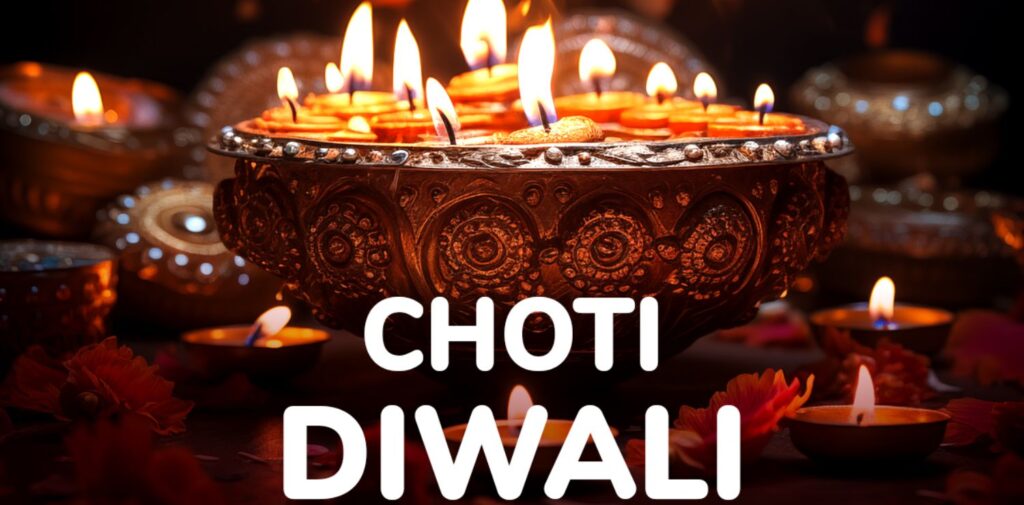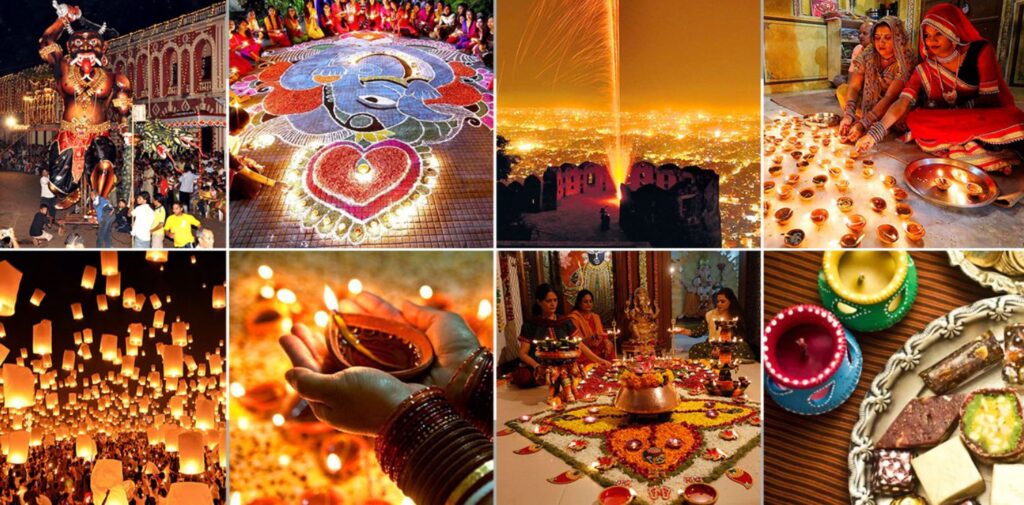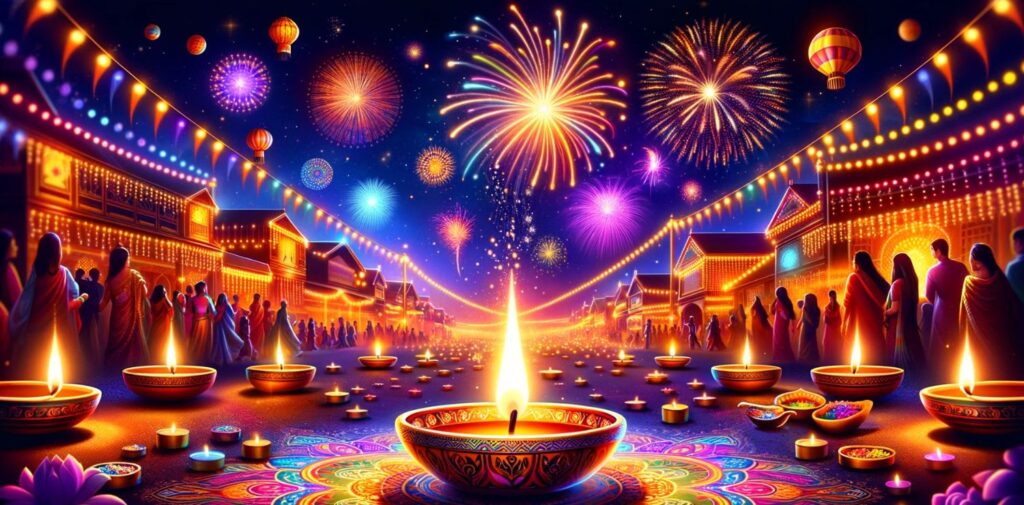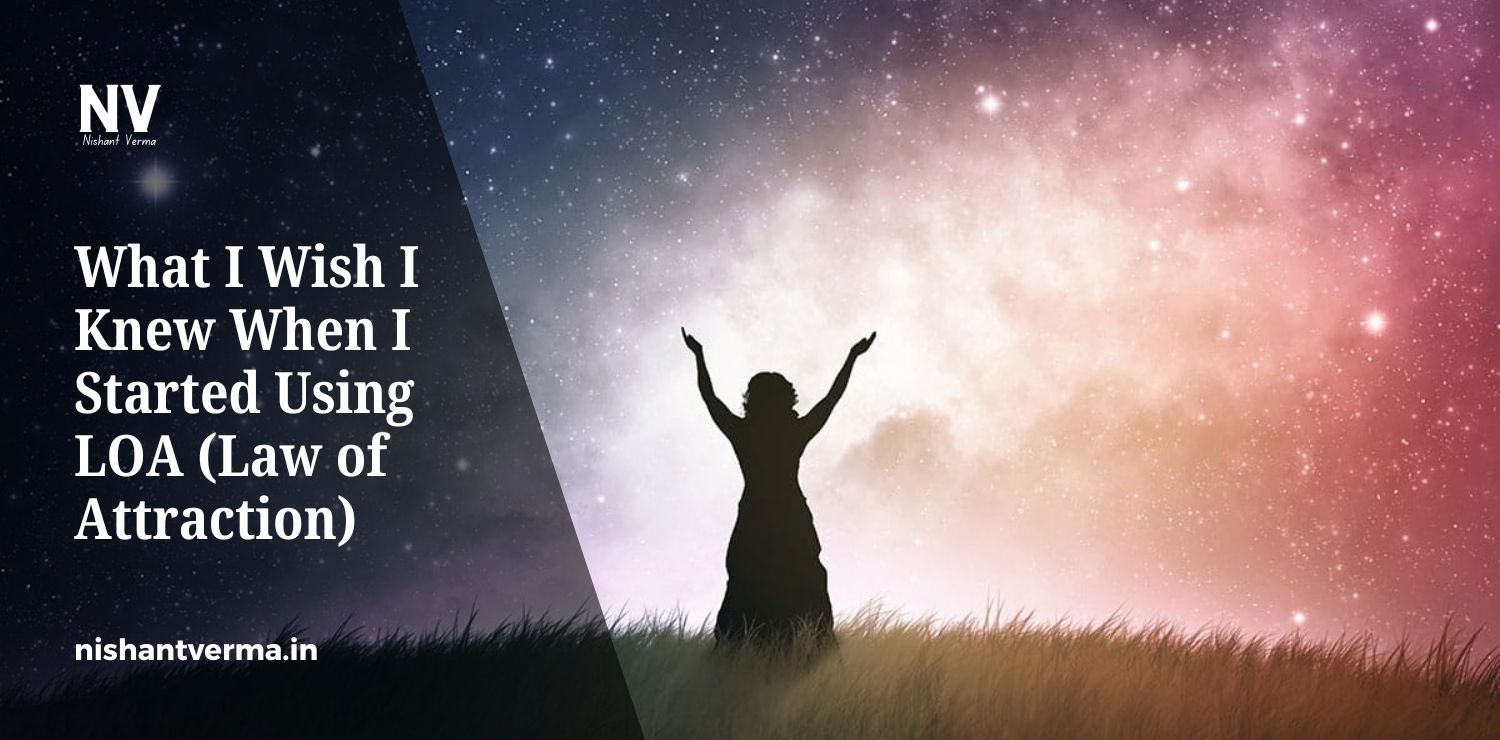Choti Diwali, also known as Naraka Chaturdashi, is a significant festival celebrated in India, marking the beginning of the five-day Diwali festival. While Diwali itself is celebrated with great fanfare, Choti Diwali holds its own importance and traditions. In this article, we will explore the significance of Choti Diwali, its customs, rituals, and how it is celebrated across different regions.
What is Choti Diwali?
Choti Diwali falls on the 14th day of the Hindu month of Kartik, just one day before the main Diwali celebration. It is a time of purification and preparation for the grand festival of lights. The term “Choti” means “small” or “little,” distinguishing it from the main Diwali festivities.

The History and Story Behind Choti Diwali
Choti Diwali, also known as Naraka Chaturdashi, is celebrated on the 14th day of the dark fortnight in the Hindu month of Kartik. It holds great significance within the Diwali festivities and is steeped in rich mythology and historical context. Let’s delve into the history and stories behind this vibrant celebration.
Mythological Background
- The Legend of Narakasura:
- Narakasura was a powerful demon king, born to the Earth goddess, Bhudevi, and the celestial being, Varaha (the boar incarnation of Lord Vishnu). Despite his divine lineage, Narakasura turned evil, gaining immense power and arrogance.
- He wreaked havoc across the heavens and earth, capturing beautiful women and forcing them to reside in his palace. His tyranny led to widespread suffering, as he tormented both gods and humans alike.
- The Destruction of Narakasura:
- The gods, unable to bear Narakasura’s cruelty, sought the help of Lord Krishna. Lord Krishna, known for his valour and wisdom, accepted the challenge to defeat the demon.
- Accompanied by his wife, Satyabhama, Lord Krishna confronted Narakasura. A fierce battle ensued, during which Narakasura unleashed all his might, but Krishna, with his divine powers, ultimately overpowered him.
- As Krishna struck the final blow, Narakasura realized his mistakes and sought forgiveness. In a show of compassion, Krishna granted him liberation, acknowledging that even those who err deserve redemption.
- The Significance of the Day:
- After defeating Narakasura, Lord Krishna liberated the women he had captured. This act symbolizes the restoration of dignity and honour, representing the victory of righteousness.
- The day is celebrated as Naraka Chaturdashi, marking the triumph of good over evil and serving as a reminder of the importance of justice.
Cultural Significance
- Celebration of Light:
- Choti Diwali is often considered the day when the darkness of Narakasura’s reign was dispelled by the light of Lord Krishna’s victory. This theme of light overcoming darkness is central to Diwali celebrations.
- The lighting of diyas (oil lamps) and candles on Choti Diwali signifies the dispelling of ignorance and negativity, welcoming positivity and prosperity into homes.
- Rituals of Purification:
- On this day, it is customary for devotees to take an early morning bath, often with herbal powders and oils. This ritual symbolizes purification, washing away sins, and preparing for the joyous days ahead.
- The cleansing act serves as a metaphor for spiritual renewal, reinforcing the idea that one should strive for goodness and virtue.
- Community and Family Bonding:
- The celebration emphasizes the importance of community and familial bonds. Exchanging sweets, visiting friends and relatives, and performing rituals together strengthen ties and foster a sense of togetherness.

Historical Context
- Integration into Diwali:
- Over time, Choti Diwali has become an integral part of the larger Diwali festival. While Diwali itself celebrates the return of Lord Rama to Ayodhya after defeating Ravana, Choti Diwali connects to the theme of good triumphing over evil in a different narrative.
- This integration reflects the diverse ways in which different regions and cultures in India interpret and celebrate the festival.
- Regional Variations:
- Different regions of India celebrate Choti Diwali with unique customs and rituals, influenced by local traditions and historical narratives. For example, in South India, the day is primarily focused on the story of Narakasura, while in North India, it serves as a precursor to the grand Diwali celebrations.
- Evolution of Celebrations:
- With modern influences, Choti Diwali has evolved, but its core values remain intact. Families continue to engage in rituals, but there is also a growing emphasis on eco-friendly celebrations, reducing the impact of fireworks on the environment.

Customs and Traditions
Choti Diwali is celebrated with various customs, which may vary by region. Here are some common practices:
- Morning Rituals:
- People wake up before sunrise to perform a ceremonial bath, which is considered purifying.
- This ritual often involves using herbal powders or oils, symbolizing cleansing and renewal.
- Puja (Prayer Rituals):
- After bathing, families perform a puja dedicated to Lord Krishna and other deities.
- Offerings of sweets, fruits, and flowers are made, seeking blessings for health and happiness.
- Lighting Diyas and Decorations:
- Homes are decorated with diyas and colourful lights to symbolize the victory of light over darkness.
- Rangoli designs are created at entrances to welcome guests and bring good fortune.
- Fireworks and Sparklers:
- Fireworks and sparklers are common, adding to the festive spirit, although celebrations may be more subdued than on the main Diwali day.
- Preparing Sweets:
- Families prepare a variety of sweets and snacks, which are shared with friends and neighbours, reinforcing communal bonds.
- Charity and Community:
- Many use this occasion to give back to the community, donating to those in need and sharing the joy of the festival.

Regional Variations in Celebration
Choti Diwali is celebrated in various ways across different parts of India. Here are some regional variations:
- North India: In many northern states, Choti Diwali is marked with the worship of Lord Krishna and the lighting of diyas. People also engage in decorating their homes with colourful lights and rangoli.
- South India: In southern states, Choti Diwali is often observed with the ritual of taking an oil bath. This day is known as Naraka Chaturdashi, and people believe that it brings good fortune and prosperity. Special dishes are prepared, and families come together to celebrate.
- Maharashtra: In Maharashtra, Choti Diwali is celebrated by exchanging sweets and gifts among friends and relatives. People often visit temples and participate in community celebrations.
- Gujarat: In Gujarat, Choti Diwali is celebrated with vibrant decorations and elaborate feasts. Many families also perform special prayers to Goddess Lakshmi, the goddess of wealth.
- West Bengal: In West Bengal, Choti Diwali coincides with the celebration of Kali Puja. Devotees worship Goddess Kali, seeking her blessings for strength and protection from evil.
Celebrating Choti Diwali Today
In modern times, Choti Diwali has evolved, but its essence remains unchanged. Here are some contemporary ways people celebrate this festival:
- Community Gatherings: Families and friends often come together to celebrate Choti Diwali, strengthening bonds and sharing joy.
- Eco-Friendly Celebrations: With increasing awareness of environmental issues, many people are opting for eco-friendly diyas and avoiding harmful firecrackers. This approach promotes a safer and more sustainable celebration.
- Digital Greetings: In today’s digital age, people send e-cards and messages to wish each other happiness and prosperity, making it easier to connect with loved ones who may be far away.
- Charity and Giving: Many people use this occasion to give back to the community by donating to charities, helping those in need, and sharing their blessings.
Conclusion: Choti Diwali 2024
Choti Diwali is a festival rich in mythology and cultural significance. The story of Narakasura’s defeat by Lord Krishna serves as a powerful reminder of the victory of good over evil, the importance of justice, and the potential for redemption. As families and communities come together to celebrate this day, they reinforce the values of love, compassion, and hope. The rituals of purification and the lighting of diyas symbolize the quest for positivity and prosperity, making Choti Diwali a cherished part of the larger Diwali festivities.




